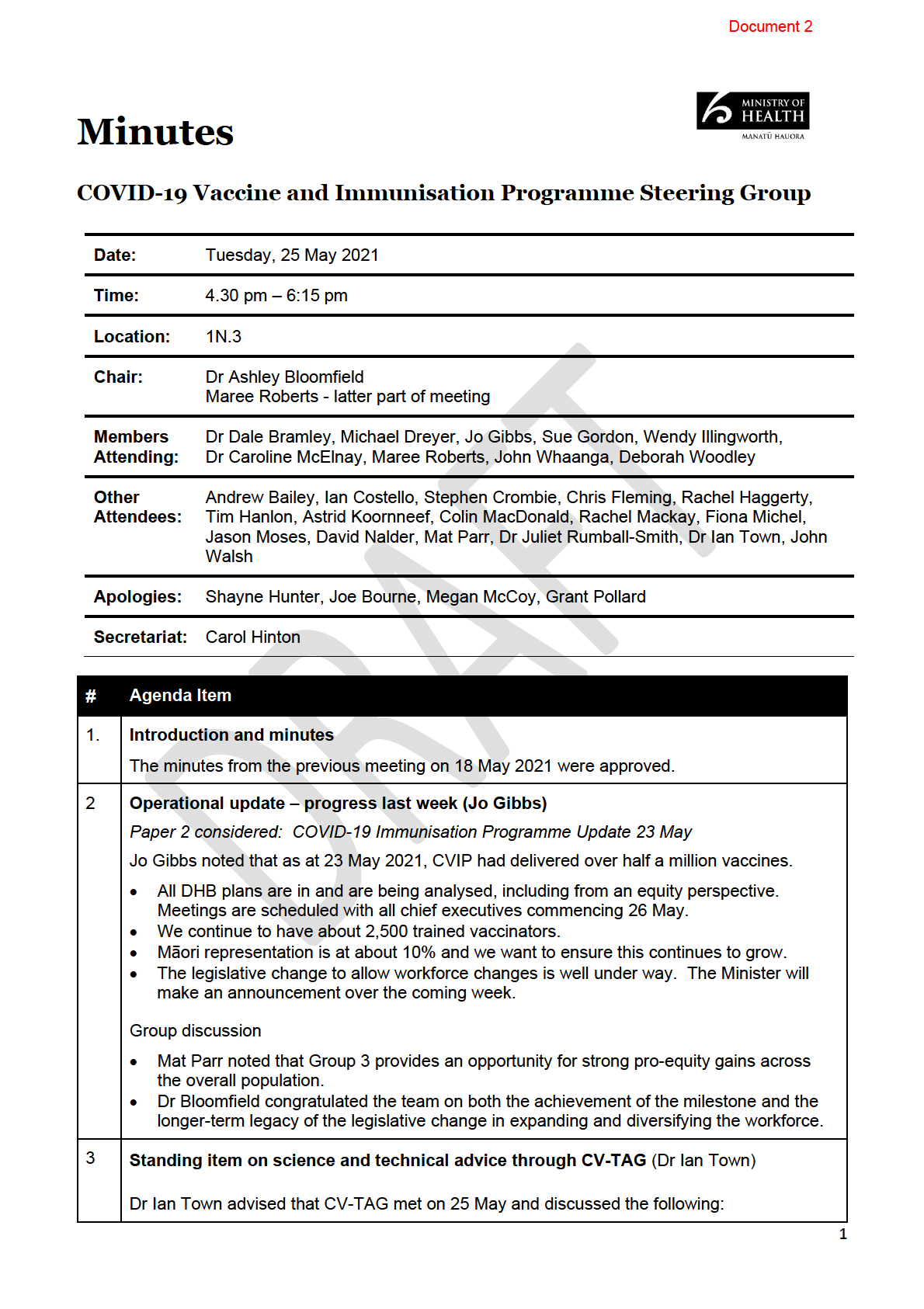
1982
ACT
INFORMATION
OFFICIAL
THE
UNDER
RELEASED

1982
ACT
INFORMATION
OFFICIAL
THE
UNDER
RELEASED

1982
ACT
INFORMATION
OFFICIAL
THE
UNDER
RELEASED
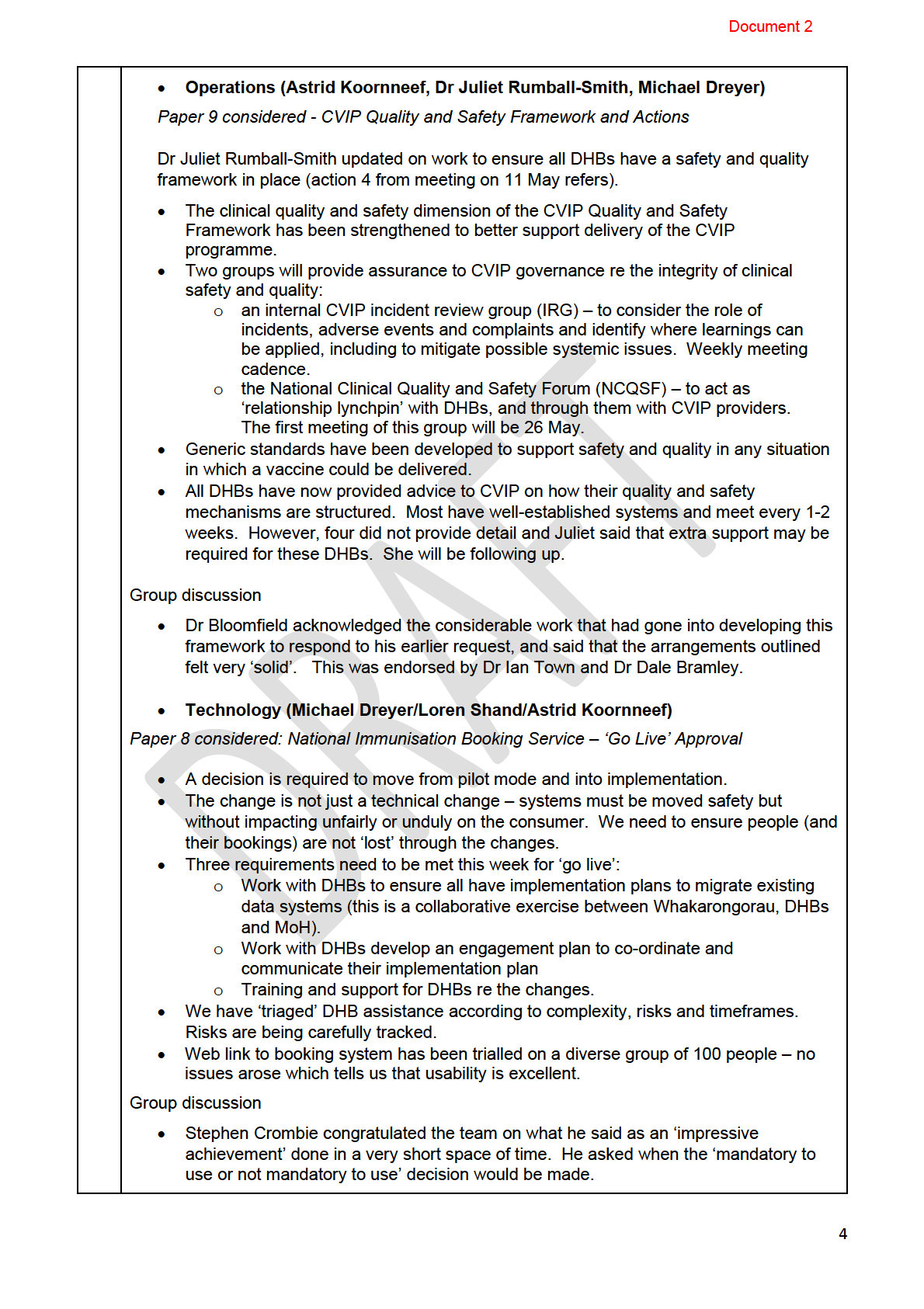
1982
ACT
INFORMATION
OFFICIAL
THE
UNDER
RELEASED
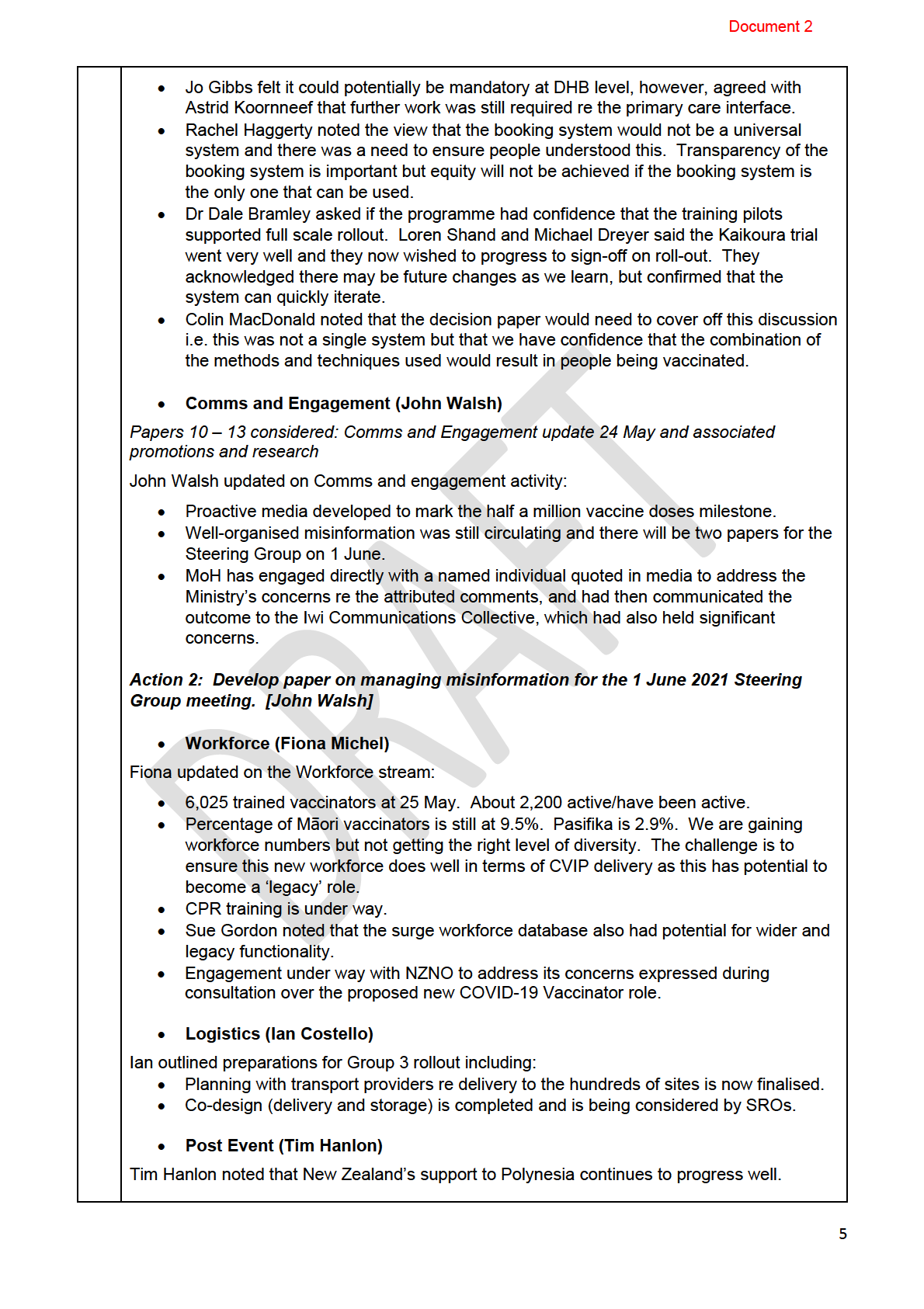
1982
ACT
INFORMATION
OFFICIAL
THE
UNDER
RELEASED
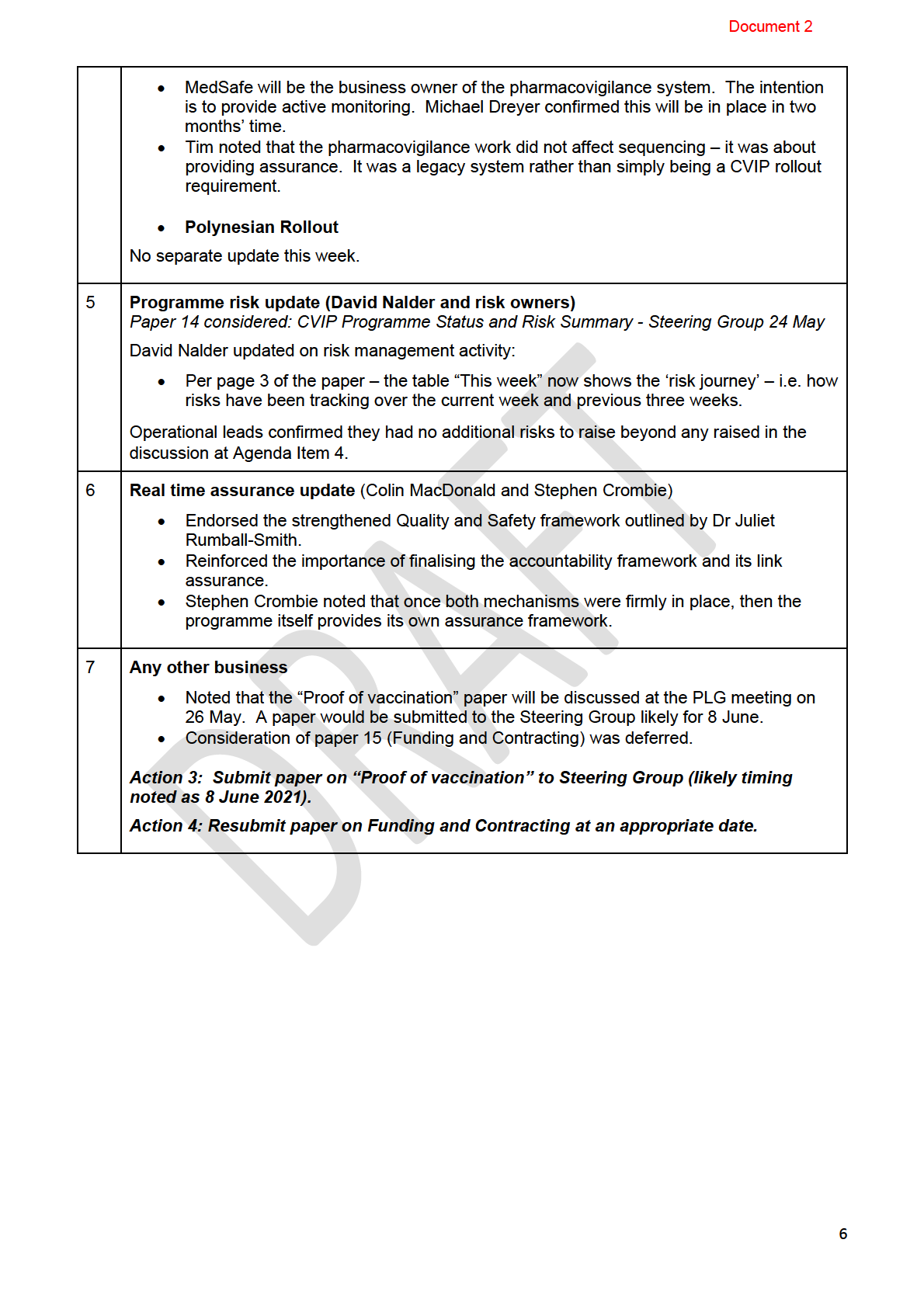
1982
ACT
INFORMATION
OFFICIAL
THE
UNDER
RELEASED
Document 2
Out of scope
1982
ACT
INFORMATION
OFFICIAL
THE
UNDER
RELEASED
7

1982
ACT
INFORMATION
OFFICIAL
THE
UNDER
RELEASED
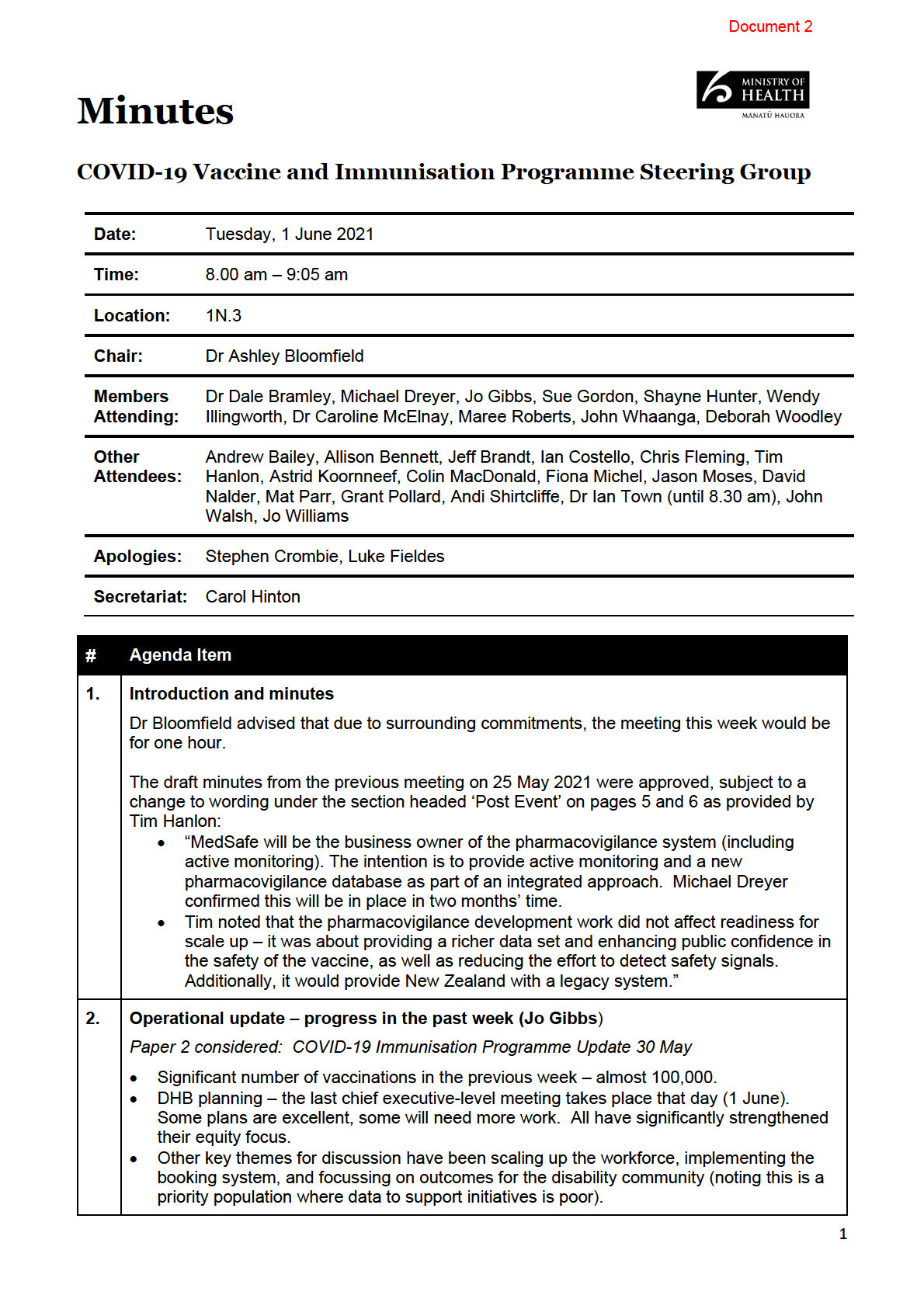
1982
ACT
INFORMATION
OFFICIAL
THE
UNDER
RELEASED
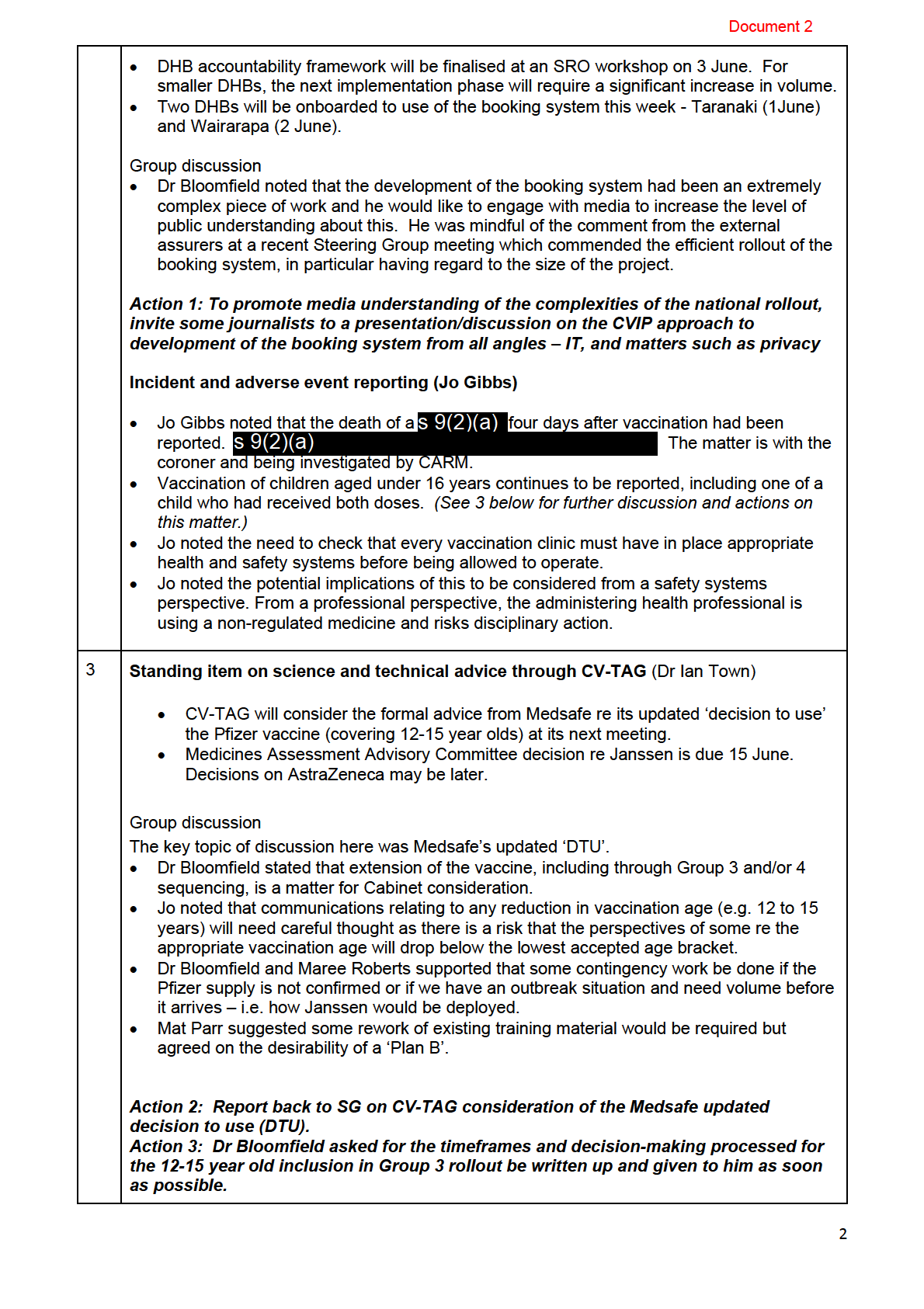
1982
ACT
INFORMATION
OFFICIAL
THE
UNDER
RELEASED
Document 2
Action 4: incorporate the Medsafe DTC, CV-TAG advice and other relevant information
into the Cabinet paper on readiness for general roll-out.
Action 5a: John Walsh to consider the communications required if NZ has to deploy
the Janssen vaccine under urgency.
Action 5b: Develop a ‘Plan B’ in the event NZ must roll out the Pfizer vaccine in an
outbreak situation (where implementation does not rely on a state of emergency being
declared).
Action 6: Clarify the mechanism/content to communicate the CV-TAG advice that the
Pfizer vaccine can routinely be offered at any stage of pregnancy,
Action 7: ensure that Minister Verrall is advised of how it wil be communicated that
the Pfizer vaccine can routinely be offered at any stage of pregnancy.
4
Programme progress against milestones (Mat Parr/Andrew Bailey)
Paper 3 considered: CVIP POAP
1982
•
Service Design (Mat Parr/Andrew Bailey)
• Key issue as we move to scale is obviously confirmation of vaccine supply. Based on
plans we are on track until end June.
ACT
• Our planning also has some ‘give’ in that it is based on 6 doses less 2%. Wastage is
decreasing over time.
• One documented risk associated with unconfirmed supply is that people who have
had dose 1 might have to wait longer for dose 2. However we have accepted the risk
on the basis of past reliability. Critical that we review delivery drop on 3 June.
Group discussion:
• Jo Gibbs noted there are several DHBs ready to go should supply become available
earlier.
INFORMATION
Strategy – implications of the Pfizer storage announcement
Paper 5 considered – change to cold-chain storage timeframe – strategy check in
• SG considered this paper and noted the four points made on pages 2 and 3.
Dr Bloomfield acknowledged the huge amount of work that had gone into preparing it.
Action 16: Adjust the second noting point in Paper 5 to add missing words, and minute
OFFICIAL
accordingly.
•
Operations (Astrid Koornneef)
THE
Paper tabled – Target dates for DHB go-live on National Immunisation Booking System
• Astrid Koornneef circulated a table showing the target dates for DHB ‘go live’ on
the national booking system, by region. Two regions go live in the current week.
• There is a high level of engagement from DHBs on this work. Astrid noted she is
UNDER
comfortable that this is well on track.
•
Comms and Engagement (John Walsh)
General communications discussion
• Focus on group 3 sequencing – CVIP working closely with wider Ministry comms
team.
RELEASED
• Planning session for group 4 scheduled for 2 June.
• Jo Gibbs noted a lit le nervousness from some DHBs about the wider communications
on something they do not yet have capacity to deliver.
• Dr Bloomfield commended the work done to date.
Paper 7 considered: Ethnic Communities engagement and communication plan
3
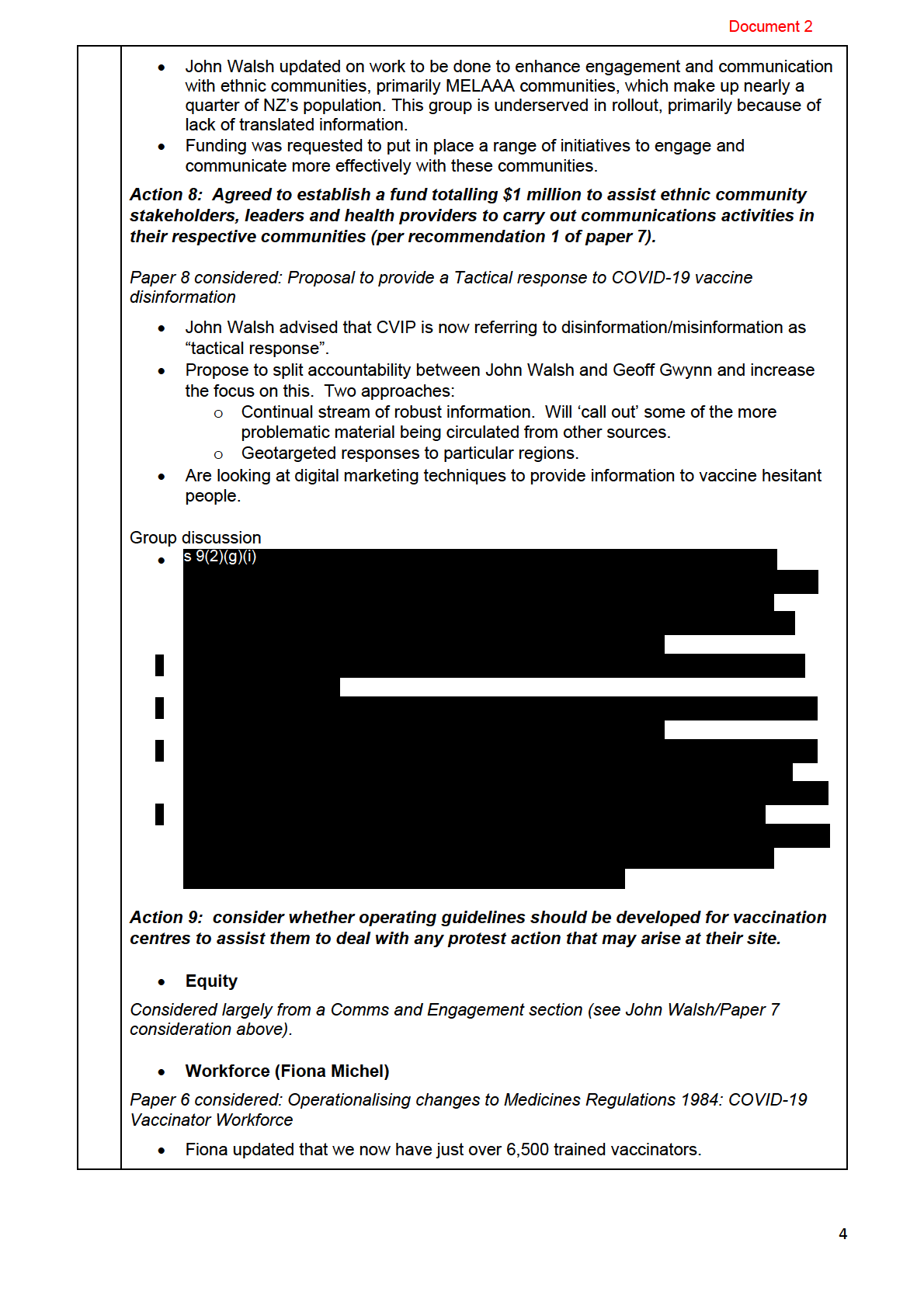
1982
ACT
INFORMATION
OFFICIAL
THE
UNDER
RELEASED
Document 2
• In developing the proposals for the necessary legislative change to support the new
COVID-19 vaccinator role, we have undertaken ‘light’ consultation. This
acknowledges current wider sensitivities.
• There wil be a ‘soft launch’. Noted that the Minister is supportive of the work
proceeding. A ministerial announcement may potentially be made at some future
point.
Group discussion
• John Whaanga endorsed this work as positioning for future workforce development
and expansion. It contributed very well to the ‘legacy’ component of rollout.
• In response to a question, Fiona confirmed that DHBs and providers are literally
‘waiting for the pack’ to arrive so they can begin with the training of people for this new
role. Some have already developed plans for working with Kaiāwhina workforce.
1982
Decisions in relation to Paper 6:
• Agreed to recommendation 2 – “to a minimum requirement ratio of a maximum 1:6
Supervisor: COVID-19 Vaccinator”
ACT
• Agreed to recommendation 3 – “to the definition of Supervision in the context of the
Vaccination Clinical Supervisor role, as described at paragraph 27 of the paper”.
• Agreed to recommendation 9 – “to amend the relevant COVID-19 Immunisation
Service Standards and associated artefacts”. (S
ee note below)
• Agreed to receive further information on point 7 to enable a decision to be made by
SG in the future
• Noted – points 1, 4, 5, 7 and 8.
Note for the Minutes: Recommendation 9 includes the training material – action 5 from
INFORMATION
meeting on Tuesday 11 May
Action 10 - Give effect to the decisions in regard to this Paper 6.
•
Logistics
No separate update this week due to shorter meeting duration.
OFFICIAL
•
Post Event
No separate update this week due to shorter meeting duration.
THE
•
Polynesian Rollout
No separate update this week due to shorter meeting duration.
5
Quality Framework (Luke Fieldes, Al ison Bennett)
UNDER
Papers 10 & 10a considered: Proposed Quality Framework for COVID-19 and powerpoint
Alison Bennett updated on work to develop the Quality Framework (previously the Success
Framework)
• The Quality Framework aims to establish expectations about services delivered under
the CVIP, and how these are experienced by New Zealanders.
• Also allows us to assess the overall success of CVIP implementation.
RELEASED
• Do not want to set targets – but want to be able to portray implementation in a
successful light.
• Six key dimensions are proposed: effectiveness, equity, efficiency, experience,
honouring Te Tiriti, sustainability/legacy impact.
• The current draft incorporates stakeholder consultation. Rich feedback has been
received from the IIAG.
Group discussion
5
Document 2
• Dr Bloomfield commended the work on the framework. His main suggestion was to
suggest that ‘safety’ be made explicit, noting that communications about the
programme have always been reinforced it as being ‘safe and effective’.
• Mat Parr noted that efficiency is closely linked to how we manage supply and have
everyone offered vaccination by year end.
• Sue Gordon agreed that the detail of the framework was very good, but agreed that
fewer measures would make it easier to ‘tell the story’.
Action 11: Put an outline of the framework into the forthcoming Cabinet paper on
readiness for rollout.
Action 12: Consider changes to the quality framework to ensure ‘safety’ is an explicit
feature, and to consider whether/how efficiency could be combined with effectiveness.
6
Programme risk update (David Nalder and risk owners)
Paper 11 considered: CVIP Programme Status and Risk Summary – 1 June 2021
1982
• David Nalder advised that an exercise to match key risks to the Success (Quality)
Framework had just been completed and he would report back to the Steering Group
ACT
in a fortnight.
• Dr Bloomfield noted that achieving equity objectives was a key risk. Jason Moses
agreed that CVIP needed to be confident that DHBs understand their populations and
how to reach them for vaccination rollout.
• Jason advised that DHBs are well engaged for rol out. DHB plans have all been
considered for equity, and some are very good. Some have targets but others do not.
He is encouraged by planning work to date, but the proof wil be in implementation.
No additional risks were raised by members.
INFORMATION
Action 13: Bring paper to Steering Group 15 June meeting to show where controls are
embedded and that risks are being appropriately managed.
7
Real time assurance update (Colin MacDonald and Stephen Crombie)
• Reinforced the importance of finalising the accountability framework and receiving
active plans from DHBs which show the framework as the basis of their future
OFFICIAL
performance. The workshop scheduled for 3 June was important in supporting this.
8
Privacy Impact Assessments (Geo
THE
ff Gwyn)
Paper 12 considered: National Booking System – Privacy Impact Assessments (internal
memo and two significant assessment documents covering Pre-event and First Phase, and
Second Phase)
• Geoff Gwyn noted that the Ministry had worked with the Of ice of the Privacy
UNDER
Commissioner and the Chief Government Privacy Officer to develop the assessments
of Pre-event/First Phase, and Second Phase of development and planned release of
the National Booking System (NBS).
• Assessment included verification against the 13 rules of the Health Information
Privacy Code 2020.
• For Phase 2, all but two rules were low risk (storage/security of information, and
accuracy of information) were medium risk.
RELEASED
Action 14: Agreed to the next steps (set out on page 5 of the paper) as per
recommendation 8 of the paper.
6
Document 2
9
Any other business
• An outline Cabinet paper on CVIP Readiness for General Roll-out has been
considered by the Minister’s office and wil be considered by Cabinet on 8 June.
Jo Wil iams/Mat Parr hold the pen to finalise.
• Sue Gordon noted a recent internal CVIP paper that mentioned consultation with
specific organisational roles, one of which she holds. She asked that authors ensure
that relevant roles with the Ministry are consulted appropriately when drafting papers
on matters of relevance to them.
• Dr Bloomfield acknowledged the significant amount of work that has been done to
keep New Zealand free of COVID-19, in particular since the start of quarantine-free
travel.
Action 15. Ensure that relevant roles with the Ministry are consulted appropriately on
matters of relevance to them.
1982
Action 17: Ensure that implementation and comms approaches are informed by
analytics and behavioural insights, and that the CVIP programme rollout is informed by
and aligned with wider MoH intelligence in this regard.
ACT
Out of scope
INFORMATION
OFFICIAL
THE
UNDER
RELEASED
7
Document 2
Out of scope
1982
ACT
INFORMATION
OFFICIAL
THE
UNDER
RELEASED
8
Document 2
Out of scope
1982
ACT
INFORMATION
OFFICIAL
THE
UNDER
RELEASED
9
Document 2
Out of scope
1982
ACT
INFORMATION
OFFICIAL
THE
UNDER
RELEASED
10

1982
ACT
INFORMATION
OFFICIAL
THE
UNDER
RELEASED
Document 2
2
Operational update – progress last week (Jo Gibbs)
Paper 2 considered: COVID-19 Immunisation Programme Update
• Jo Gibbs noted that the Vaccine Ministers’ meeting was being used in a more
structured way and now included an action tracker. A demonstration of “Book my
Vaccine” was also planned for Ministers.
• Dr Ashley Bloomfield endorsed that the recent meeting with Vaccine Ministers had
been very productive, with endorsement to the key communications messaging
surrounding the delivery of the new Pfizer supply and Groups 3 and 4. It was noted
that the actual detail of Pfizer vaccine delivery to New Zealand wil not be publicised.
• Jo Gibbs indicated that currently most DHBs are flagging more capacity to vaccinate
than we are allowing them to use at present.
Action 2: Circulate the Action Tracker developed to support Vaccine Ministers’
meetings.
1982
Action 3: Confirm that the Minister for COVID-19 made his media announcement
confirming the supply of Pfizer in July 2021.
ACT
•
Post-event reporting
• Dr Tim Hanlon gave a brief update on the recent issue with a number of Serious AEFIs at
s 9(2)(a)
. These
had all been down-graded from anaphylaxis to hypersensitivity reaction. There was no
batch issue identified. The Clinical Quality and Safety Team have connected with s 9(2)(a)
service standards and clinical governance.
3
Standing item on science and technical advice through CV-TAG (Dr Ian Town)
INFORMATION
• Dr Ian Town advised that, following the recent confirmation from Pfizer, the Minister was
likely to make an announcement relating to use of the Pfizer vaccine by pregnant women
the following day. MoH would write to CEOs before this announcement.
• There wil also be an announcement this week about a new VAANZ research project into
immunogenicity. MBIE is providing $2 mil ion to support this. Māori and Pasifika will be
OFFICIAL
strongly represented.
• Medsafe is expected to make its announcements about the Janssen vaccine in mid-June.
Noted that a policy paper regarding use of the Janssen COVID-19 vaccine in
THE
New Zealand wil be required.
• Some work is under way relating to targeted vaccination in an outbreak situation. Andrew
Olds of NRHCC is engaged on this work.
• Note:
The discussion about
UNDER
CV-TAG consideration of the Medsafe ‘Decision to Use’ the
Pfizer vaccine for those aged 12-15 years is recorded in section 7 of these Minutes.
Action 4: Develop a paper on the ‘who/what/when re use of the Janssen vaccine within
the New Zealand/CVIP context.
4
Programme progress against milestones (Andrew Bailey/Cam Elliott)
Paper 4 considered: CVIP POAP – 4 June
RELEASED
Paper tabled: COVID-19 Vaccination Programme [A3 table of cost breakdowns]
• Cam Elliott tabled a paper showing original and revised forecasts re CVIP funding and
the rationale for change. He advised that before the May Budget, we had signalled an
additional funding requirement of $350-400 mil ion to Ministers. This has now been
refined to $360 mil ion.
• Key changes relate to immunisation scheduling, and a big increase in activities
supporting Equity. There are some savings on the purchasing side likely to be offset.
2
Document 2
• We are actively engaged with Treasury. Main feedback is they want absolute clarity of
what is required and why.
Group discussion
• Dr Bloomfield said that $360 mil ion is a significant amount of additional money and he
will go through the figures in more detail.
• Jo Gibbs noted it was also useful to understand what are ‘commit ed costs’
irrespective of activity, and what costs are activity-dependent.
• Sue Gordon noted the need to think about COVID-19 costs and invoicing more widely,
cautioning that we do not want to find ourselves in a huge ‘wash up’ situation with
DHBs.
•
Equity (Jason Moses)
Jason Moses advised that the current focus is ensuring enough is being done to promote and
1982
achieve equity through provider implementation plans. Planning is currently a mix of
production targets and narrative.
General discussion
ACT
• Dr Bloomfield advised that he has been concerned to see the flu vaccination rates this
year which show Māori at below 80%. This has real implications for COVID-19
vaccination.
• Dr Bloomfield emphasised the critical importance of all DHBs having a very strong
implementation focus on equity. He asked if DHBs had actual production targets.
This would help give the Ministry the level of granularity required in terms of
monitoring
• Jason indicated that about 8 DHBs have production targets. Some are stronger with
their equity narrative. He cited Southern DHB as a good example.
INFORMATION
• Dr Dale Bramley supported this, noting he held similar concerns. He agreed with the
idea of providing suggestions to DHB chief executives about actions and approaches
they could take.
• Jo Gibbs indicated that DHBs should all be well aware of the expectations and noted
that equity, workforce and data/digital were standard items for discussion with DHBs
and included in their accountability framework.
OFFICIAL
•
National Booking System (A
THE
strid Koornneef)
Astrid Koornneef advised that the booking system was now being rolled out in some DHBs.
• The key question was whether we wanted a ‘one system for all’ approach, or to be
able to take different approaches where required e.g. for dif erent types of provider.
• A centralised approach offers a number of benefits including an ability to see the
UNDER
whole customer journey, to monitor and measure progress and success, and better
ability to maintain data integrity.
• Some of the disbenefits include the fact the booking system is not integrated with the
CIR (immunisation register), gaps in overall data, and the fact that ‘all provider’
onboarding is not aligned to the roll-out sequencing. To achieve this would require
significant resource effort. Delayed start is a likely consequence.
• Astrid also noted that uptake by the primary care sector may be variable – many
RELEASED
general practices have well-developed, well-recognised systems which they prefer to
continue to use. Pharmacies appear to have more readiness to accept the booking
system.
Group discussion:
There was robust discussion over the extent to which the National Booking System should or
should not be mandated:
3
Document 2
• Jo Gibbs noted that it may be necessary to mandate the booking system for any
primary care or hauora providers who do not have their own system already.
• Shayne Hunter noted that there wil always be a data gap, regardless of whether there
is a centralised system or not, because not everyone wil book. He had spent a lot of
time with primary care providers and noted that many operate multiple systems. He
cautioned about the need to be clear that we understand these before we mandate
additional systems.
• Stephen Crombie and Colin MacDonald endorsed this, saying that there was a risk of
adding uncertainty and variability into primary care.
• Jo Gibbs agreed that the ‘mandating’ may be about the need to provide certain
information, rather than the mechanism through which it is provided.
• In response to a question from Dr Bloomfield, Astrid confirmed that a provider not
using the booking system wil not appear as a ‘provider option’ for people who choose
to book through the system. Michael Dreyer noted that in the UK, providers who 1982
wanted to access the ‘pool’ of people wanting to be vaccinated therefore used the
centralised booking system.
• Michael Dreyer also noted that at this point the booking system is not yet proven.
ACT He
felt mandating would be premature. Sue Gordon agreed that there would need to be a
delay in roll-out if the booking system was to be mandated.
• Dr Dale Bramley noted that we need visibility of what is going on, and where and
asked if standardised tracking and reporting would consolidate those views?
• It was agreed that the fundamental information needed for success of the programme
is whether someone has been vaccinated, and who they were.
• Maree Roberts noted her understanding that ministerial interest was in assuring that
as many New Zealanders as possible received their vaccinations.
INFORMATION
•
National Call Centre (Astrid Koornneef)
Astrid Koornneef updated that she has met a group of the large government agencies
(including MBIE, IRD, MSD, Internal Affairs, ACC) to discuss their ability to provide surge
capacity for messaging for Group 3. OFFICIAL
• CVIP needs to be cleared about what we expect ‘surge’ to look like and she will be
getting back in touch with those she met to clarify this and offer assistance to remove
any barriers.
THE
• Initial indications are that the ability of these agencies to scale up is limited, and only
MBIE and ACC said they may have some capacity. However they do not have
weekend capacity and have month-ed commitments.
• We have asked DHBs to further scale up their call centres as they are likely to need
some level of surge capacity to handle bookings.
UNDER
•
SRO Workshop (Fiona Michel)
Fiona Michael advised that the workshop of Senior Responsible Of icers was held on the
previous Thursday with al DHBs except Tairāwhiti (fog cancelled flight) in personal
attendance. It as a constructive workshop. Key issues covered:
• Attendees
RELEASED acknowledged the need for dependability and confidence in the process as
the vaccination programme rolls out.
• Discussion on how DHBs can bet er align delivery processes, including for scale-up.
• Looked at ‘pain points’ and ‘what works well’. Attendees were happy to share
experiences and learnings.
• A good discussion on ‘human factors’ surfaced dif erences between what is important
to government, vs Chairs, vs CEOs, vs the consumer.
• Considerable discussion that ‘alignment’ does not mean ‘consistency’. For example it
was agreed there wil be valid reasons why large, medium, and small DHBs may all
4
Document 2
have different approaches to the same broad issue depending on the size of their
DHB.
•
Comms and Engagement (John Walsh)
Papers 5, 5a and 5b considered: Comms and Engagement support for COVID-19 vaccine
rollout
John Walsh advised of the several big announcements for the week:
• Confirmation that New Zealand wil receive 1 mil ion doses of the Pfizer COVID-19
vaccine during July 2021;
• Confirmation of high level information of Group 4 roll-out;
• Decisions relating to the ability of 12-15 year olds to receive the Pfizer vaccine;
• A decision from Medsafe re use of the Janssen vaccine in New Zealand;
• Announcement of dates for the mass vaccination clinic.
1982
John also advised that:
• Campaign planning for Group 4 wil be completed by 11 June.
ACT
• Some in Group 3, who had expectations that they would have had their vaccination
date/s confirmed by now, have become a lit le unsettled and this is evident in some
media coverage. John noted that members of the disability community were amongst
those keen to see action.
Group discussion:
• Dr Bloomfield noted that the more information we can provide to the public about
‘when and how’ the better.
INFORMATION
•
Workforce (Fiona Michel)
Fiona updated on workforce statistics:
• About 7,000 trained vaccinators as at 8 June.
• Percentage of Māori vaccinators is still at 9.18% - a slight drop over the previous
fortnight.
OFFICIAL
Paper 6: Employment Relations and the COVID-19 Vaccinators
THE
• Commencement of the new role of COVID-19 Vaccinator was recently gazetted.
• Rates of pay and terms and conditions of employment have been agreed with the PSA
and APEX. NZNO continues to oppose the role.
Group discussion
UNDER
• Dr Dale Bramley noted his broad support for the COVID-19 role and proposals, seeing
the legacy opportunities from creation of this role.
• Fiona clarified that DHBs (rather than MoH) would employ many of those in the new
role and the recommended pay rates related to DHB employment terms and
conditions.
• Commissioned providers may choose to employ COVID-19 vaccinators directly via a
collective or individual employment agreement. DHBs should fund these roles in line
with the D
RELEASED HB recommended pay rates.
Decisions:
Agreed that COVID-19 Vaccinators will be employed via DHBs rather than the Ministry
of Health;
Noted that some commissioned providers may choose to employ COVID-19
Vaccinators directly;
Agreed that the existing PSA and APEX collective agreements with DHBs can be used
to provide coverage for the role of COVID-19 Vaccinator;
5

1982
ACT
INFORMATION
OFFICIAL
THE
UNDER
RELEASED
Document 2
• Following feedback from Dr Bloomfield, ‘Safety’ had now been included as a headline
measure. The four headline indicators (ef iciency, equity, safety, experience) are all
considered to have direct alignment with the success dimension.
Group discussion
• Dr Bloomfield noted he was happy with how the framework was progressing.
• Jo Gibbs suggested further consideration be given to having ‘not completed vaccine
course within six weeks’ as a safety measure. She noted that due to supply
constraints, some people are being delayed longer than this.
• Dr Dale Bramley suggested consideration by given to adding ‘equity’ to the box on
page 2.
Action 8: Al ison Bennett and Jo Gibbs wil further consider the ‘six weeks’ safety
measure offline, and consider how equity can be added as suggested.
1982
6
Review of non-residents’ eligibility (Wendy Il ingworth) Paper 9 considered: Review of non-residents’ eligibility for COVID-19 vaccines – 4 June 2021
ACT
• Wendy Il ingworth, deputising for Cassie Pickett, advised that under the COVID-19
Eligibility Direction 2021, everyone in NZ is eligible to receive the COVID-19 vaccine
regardless of their immigration status. The Direction followed Cabinet decisions about
Quarantine Free Travel.
• Vaccine eligibility settings have been reviewed following changes to border settings.
However border settings are likely to continue to change. Therefore rather than
change the eligibility direction, operational tools should be used to encourage visitors
to NZ to be vaccinated in their own country. Wider QFT decisions would continue to
be monitored.
INFORMATION
Group discussion
• The meeting agreed that the population cohort most likely to seek a COVID-19
vaccination in NZ is people who are in Australia legitimately, who are not Australian
citizens, and who decide to go to NZ to be vaccinated.
• Dr Bloomfield made a number of points:
o there were difficulties in achieving a balance if offering to vaccinate overseas
OFFICIAL
nationals on holiday here, when many NZers are stil waiting for their first
vaccination;
o non-residents may be offered vaccination in NZ in certain circumstances e.g. if
THE
there is an outbreak while they are here;
o We also need to consider people here for special immigration purposes; and
New Zealanders posted overseas who are back in NZ for a few weeks.
• Dr Bloomfield requested that the paper be adjusted to provide more specificity around
UNDER
the latter part of the paper.
Action 9: Amend paper to strengthen the proposed actions/advice about the
parameters for receiving a COVID-19 vaccination in New Zealand, and on ways to
encourage visitors to New Zealand to be vaccinated in their own country.
7
Decision to use Pfizer vaccine for 12-15 year olds (Al ison Bennett) Paper 10 consider
RELEASED
ed: Decision to Use Comirnaty (Pfizer/BioNTech) COVID-19 Vaccine for
children who are aged 12-15 years
Al ison Bennett advised:
• At the time of the Cabinet decision to use the Pfizer vaccine for roll-out in New
Zealand, clinical trials had not included those aged under 16 years. Pfizer has now
applied to allow the vaccine to be used in NZ by those aged 12-15 years.
• Medsafe is working with Crown Law Of ice re use of the vaccine by those aged 12-15
years.
7
Document 2
• The paper sought Steering Group decision re how to incorporate this age group into
roll-out for groups 1 to 3.
Group discussion
• There was considerable discussion on this issue. If made now, a decision could be
included in the “Readiness for Roll-out” paper to be considered by Cabinet on 14 June.
• However, MoH would generally take a decision after Medsafe has issued its ‘Decision to
Use’ and the CV-TAG has considered the mat er and provided its technical advice to
MoH.
• Dr Ian Town advised that CV-TAG was awaiting Medsafe consideration/conditions with
interest. One potential safety issue emerging is risk of myocarditis for younger people.
However he said the ‘concerns’ re Pfizer were not so much systemic safety issues as they
were that trials have only been held on small numbers. So there was a balance to be
considered.
1982
• Dr Bloomfield noted that ultimately Cabinet would need to make the decision regarding
extension of use for the purposes of roll-out. He asked for some changes to be made to
the paper but also recognised the desirability of prompt decision-making. ACT
Action 10: At Friday’s meeting ask Vaccine Ministers to give a ‘power to act’ to some
Ministers so that decisions re use of the Pfizer vaccine in roll-out can be progressed
promptly following Medsafe and CV-TAG consideration. [Andrew Bailey/Jenny
Stevens]
Action 11: Amend the Cabinet paper on readiness for roll-out to note that Cabinet wil
be asked for a decision once Medsafe has made its decision and advice has been
received from CV-TAG. [Mat Parr/ Jo WIlliams] INFORMATION
Action 12: Consider whether the policy advice should be amended to ‘extend the age
range for provisional approval of the vaccine. [Al ison Bennett]
8
Proposed assurance framework (David Nalder)
Paper 11 considered: CVIP Assurance Framework – 4 June 2021
OFFICIAL
• David stated that successful rollout of vaccinations relied on effective design,
alignment of activity, and adequate controls.
• This paper aimed to describe how the programme wil define its future assurance
THE
needs to ensure that what is expected is done, and that critical controls relied on to
managed risk are in place and are working as expected. This includes both within the
Ministry and DHBs. There is a strong focus on using BAU processes wherever
practicable.
• Letters of Readiness wil need to be agreed with DHBs to give the Ministry confidence
UNDER
of their final approach to rollout.
(Proposed assurance framework – Cont.)
Group discussion
• Dr Bloomfield commended David on this work, saying the programme overall now had
a high degree of confidence from Vaccine Ministers. He commended the table on
RELEASED
page 6, which showed the ‘fit’ of wider programme management and accountability
documents with the proposed approach.
• The external assurers, Colin MacDonald and Stephen Crombie, endorsed that the
document was ‘comprehensive but achievable’. They supported its shift from
dependency on external assurers to self-management.
• A caution was noted to ensure the adequacy of DHB resourcing in supporting delivery
under the framework.
8
Document 2
• Sue Gordon also suggested that consideration be given to expanding the ‘three lines
of defence’ model within the framework.
Action 13: Ensure that the Assurance Framework is a scheduled time for robust
discussion at the next Steering Group meeting (15 June).
9
Any other business
Nil.
1982
ACT
INFORMATION
OFFICIAL
THE
UNDER
RELEASED
9
Document 2
Out of scope
1982
ACT
INFORMATION
OFFICIAL
THE
UNDER
RELEASED
10
Document 2
Out of scope
1982
ACT
INFORMATION
OFFICIAL
THE
UNDER
RELEASED
Document 2
Out of scope
1982
ACT
INFORMATION
OFFICIAL
THE
UNDER
RELEASED
12











